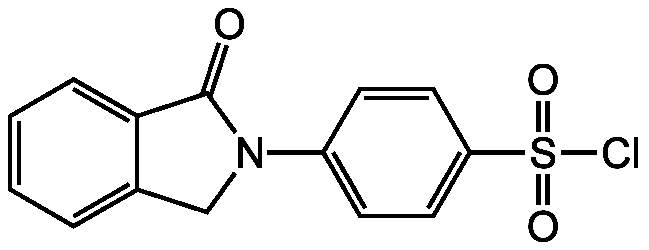
Chemical Structure
Physil chloride
CDX-P0009
CAS Number114341-14-9
Product group Chemicals
Estimated Purity>98%
Molecular Weight307.75
Overview
- SupplierChemodex
- Product NamePhysil chloride
- Delivery Days Customer10
- CAS Number114341-14-9
- CertificationResearch Use Only
- Estimated Purity>98%
- Hazard InformationWarning
- Molecular FormulaC14H10ClNO3S
- Molecular Weight307.75
- Scientific DescriptionChemical. CAS: 114341-14-9. Formula: C14H10ClNO3S. MW: 307.75. Synthetic. It is known that phenol and p-cresol are promoters of skin tumors and also urinary excretion of phenol and p-cresol is increased by exposure to benzene, which has hemopoietic toxicity, and toluene, respectively. Therefore, the determination of phenol and p-cresol is important in clinical chemistry and toxicology. Because phenol and p-cresol are present in urine as sulfate or glucuronide conjugates, they are hydrolyzed enzymatically or with acid, followed by distillation or extraction with organic solvent prior to measurement by GC or HPLC. However, these GC and HPLC methods require relatively large sample volumes (more than 1 ml) because of their insufficient sensitivities for measuring small amounts of phenol and p-cresol. The application of fluorescent labeling techniques to HPLC result in a sensitive and selective method. Phthalimidylbenzenesulfonyl chlorides habe also been successfully used for high sensitivity labelling of amino acids prior to HPLC. - It is known that phenol and p-cresol are promoters of skin tumors and also urinary excretion of phenol and p-cresol is increased by exposure to benzene, which has hemopoietic toxicity, and toluene, respectively. Therefore, the determination of phenol and p-cresol is important in clinical chemistry and toxicology. Because phenol and p-cresol are present in urine as sulfate or glucuronide conjugates, they are hydrolyzed enzymatically or with acid, followed by distillation or extraction with organic solvent prior to measurement by GC or HPLC. However, these GC and HPLC methods require relatively large sample volumes (more than 1 ml) because of their insufficient sensitivities for measuring small amounts of phenol and p-cresol. The application of fluorescent labeling techniques to HPLC result in a sensitive and selective method. Phthalimidylbenzenesulfonyl chlorides habe also been successfully used for high sensitivity labelling of amino acids prior to HPLC.
- SMILESClS(=O)(=O)C1=CC=C(C=C1)N1CC2=CC=CC=C2C1=O
- Storage Instruction2°C to 8°C
- UNSPSC41116134
